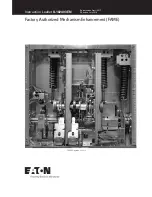
GEI-86134, Power Circuit Breakers
TRIP
PADDLE
CRANK
(
BREAKER
)
CLOSED POS I T I ON
SIDE
VIEW
MAI N
SHAFT
RESET
Ll NKAGE
FRONT
VIEW
�
0
Fig. 22. Flux shift trip device and operating
linkages
FLUX SHIFT TRIP DEVICE
The mounting arrangement of this component is
illustrated in Figs.
22
and
23.
An electromagnetic
actuator located on the underside of the front frame
is coupled to the breaker's trip shaft via a trip rod
driven by the actuator arm. The actuator is a
solenoid whose armature is spring-loaded and held
in its normal (Reset) position by a permanent mag
net. In this state the spring is compressed.
So long as the actuator remains in the Reset po
sition, the breaker can be closed and opened norm
ally at will. However, when a closed breaker re
ceives a trip signal from the programmer unit, the
actuator is energized and its solenoid flux opposes
the magnet, allowing the spring to release the arm
ature; this drives the trip rod against the trip shaft
paddle, tripping the breaker.
As the breaker opens, the actuator arm is re
turned to its normal (Reset) position via linkage
driven by a crank on the br"eaker's main shaft. The
permanent magnet again holds the armature captive
in readiness for the next trip signal.
The trip device requires only one adjustment -
the trip rod length. As shown in Fig.
24,
the clear
ance between the trip rod end and the trip shaft
paddle is gaged by a
0.125
inch diameter rod. Ad-
20
just gap to
0. 125
inch+
0. 015
inch. To adjust, open
the breaker and restore the breaker mechanism to
its Reset position. Loosen the jam nut, rotate the
adjuster end until the proper gap is attained, then
retighten the jam nut.
The actuator is a sealed, factory-set device and
requires no maintenance or field adjustment. In
case of malfunction, the complete actuator unit
should be replaced. When making the electrical
connection to the replacement unit, it is recom
mended that the breaker harness be cut at some
convenient point and the new actuator leads solder
spliced thereto. An alternate method is to untie the
breaker harness and remove the old actuator leads
directly from the female AMP connector on the end
of the breaker harness. However, AMP extraction
tool Cat. No.
305183
is required for this method.
CAUTION:
IN THE EVENT THAT THE
SST TRIP DEVICE MUST BE RENDERED
INOPERATIVE
TO
ALLOW
THE
BREAKER TO CARRY CURRENT WITH
OUT BENEFIT OF OVERCURRENT PRO
TECTION,
THE
RECOMMENDED
METHOD IS TO SHORTEN THE TRIP
ROD BY TURNING ITS ADJUSTER END
FULLY CLOCKWISE.
THIS PREVENTS
ACTUATION
OF THE
TRIP
SHAFT
PADDLE.
www
. ElectricalPartManuals
. com













































